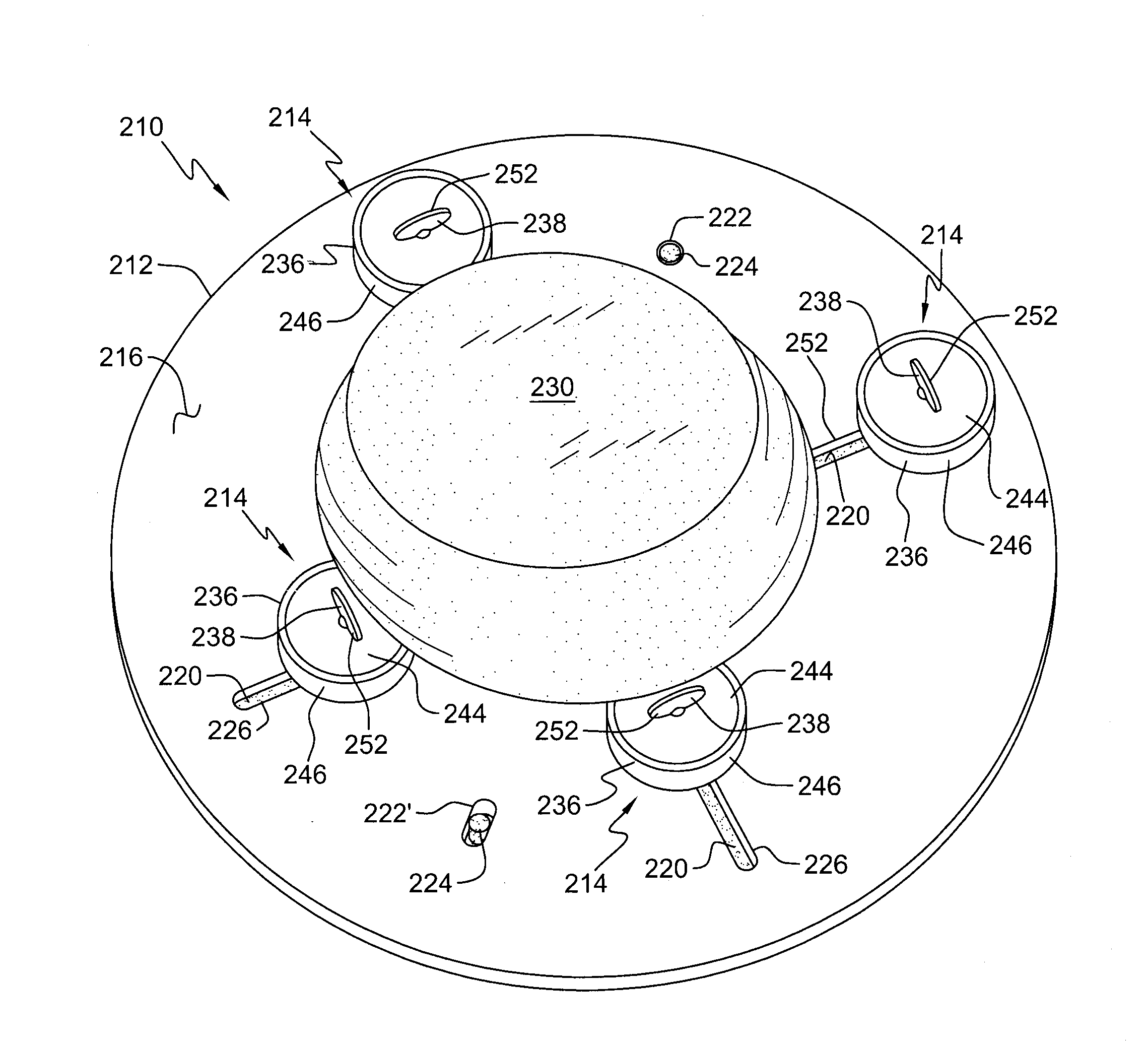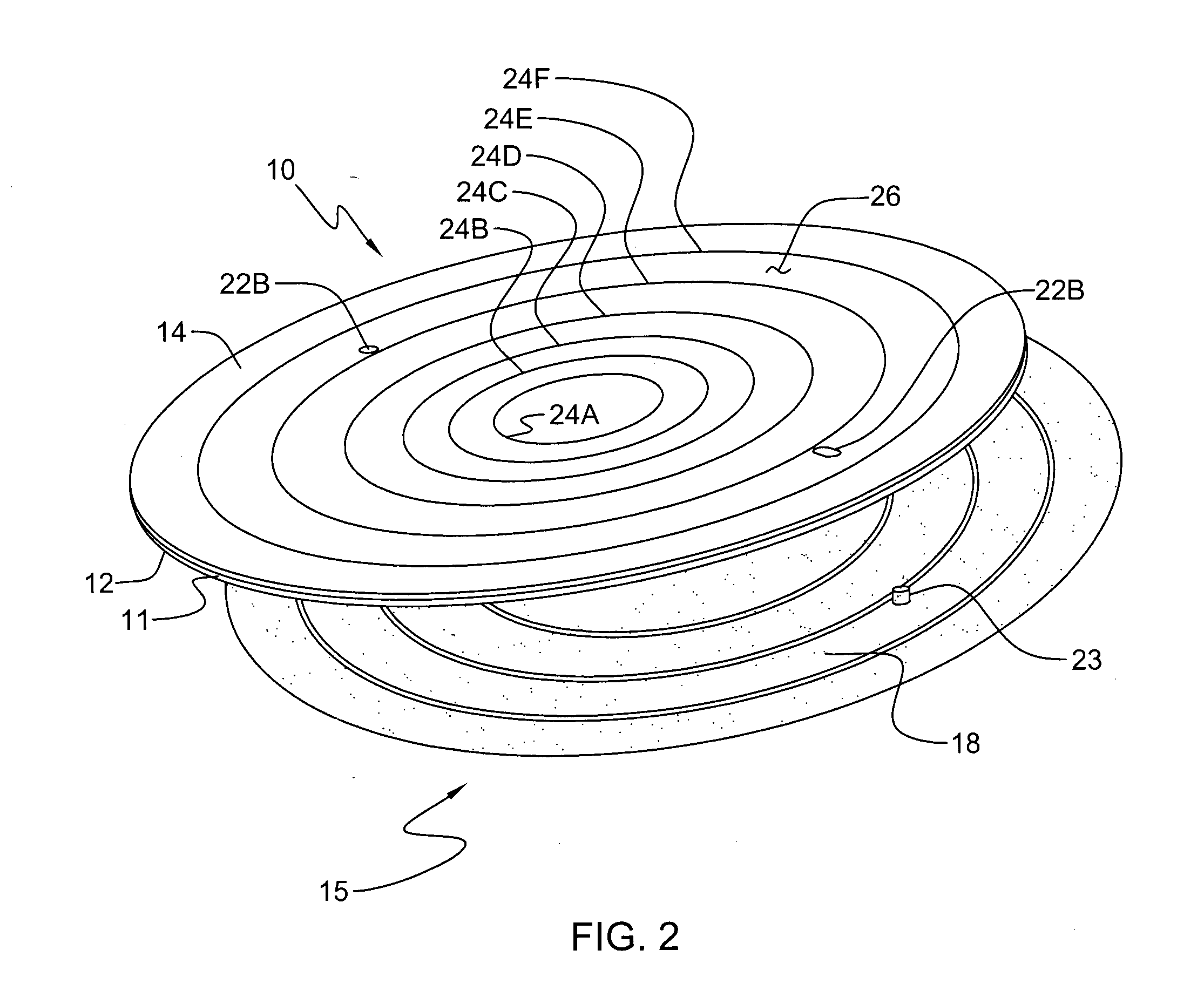Pottery holding device and method
a technology of holding device and pottery, which is applied in the field of pottery, can solve the problems of slipping, twisting or otherwise moving on the device, and not enough three points of contact with the outer surface of the workpiece for some uniquely shaped workpieces
- Summary
- Abstract
- Description
- Claims
- Application Information
AI Technical Summary
Benefits of technology
Problems solved by technology
Method used
Image
Examples
first embodiment
[0055]In FIGS. 1-6, a pottery holding device assembly embodying the present invention is indicated generally by the reference numeral 10. As shown in FIGS. 1-6, the pottery holding device 10 includes an exemplary wheelhead member 11 and at least four exemplary potter holding members 16. The wheelhead member 11 includes an exemplary bottom disc 12 and an exemplary top disc 14.
[0056]As shown in FIG. 1, the bottom disc 12 is preferably configured to be applied to the top surface of a wheelhead 18 of a pottery wheel, such as exemplary pottery wheel 15. As such, exemplary bottom disc 12 may include a planar exemplary wheelhead or bottom surface 20 sized and shaped comparable to the top surface of wheelheads. Because wheelhead sizes and shapes may differ in the marketplace, bottom disc 12 may be any size and shape that substantially corresponds to an existing wheelhead. For example, typical wheelheads are circular with diameters ranging from about 7 inches to about 16 inches, and more typ...
second embodiment
[0072]In FIG. 7, another exemplary pottery holding device embodying the present invention is indicated generally by the reference numeral 110. The exemplary pottery holding device 110 is substantially the same as the exemplary pottery holding device 10 described above with reference to FIGS. 1-6, and therefore like reference numerals preceded by the numeral “1” are used to indicate like elements. The bottom disc 112 and top disc 114 of the wheelhead member 111 of the pottery holding device 110 are the same as the pottery holding device 10, and therefore the illustrations of FIGS. 1-6 and the associated detailed description of the bottom disc 12 and top disc 14 equally apply to the pottery holding device 110 of FIG. 4. The exemplary pottery holding device 110 differs from the exemplary pottery holding device 10 with respect to the configuration of the holding members 116. In pottery holding device 110, the exemplary at least three holding members 116 (four holding members 116 illustr...
third embodiment
[0075]In FIGS. 8-14, another exemplary pottery holding device embodying the present invention is indicated generally by the reference numeral 210. Exemplary pottery holding device 210 includes an exemplary wheelhead member 212 and at least three exemplary pottery holding members 214 disposed on the wheelhead member 212. In the illustrated embodiment, the exemplary illustrated potter holding device 210 includes four exemplary pottery holding members 214 disposed on the wheelhead member 212. However, less than three and more than four exemplary pottery holding members 214 may be provided.
[0076]As shown in FIGS. 8 and 11-14, the top surface of the wheelhead member 212 defines an exemplary working surface 216, and as shown in FIGS. 9 and 10, the bottom surface of the wheelhead member 212 defines an exemplary wheelhead surface 218. The wheelhead member 212 is preferably configured to be applied to the top surface of a wheelhead 220 of a pottery wheel, as shown in FIGS. 8 and 12-14. As su...
PUM
| Property | Measurement | Unit |
|---|---|---|
| diameters | aaaaa | aaaaa |
| diameters | aaaaa | aaaaa |
| diameter | aaaaa | aaaaa |
Abstract
Description
Claims
Application Information
 Login to View More
Login to View More - R&D
- Intellectual Property
- Life Sciences
- Materials
- Tech Scout
- Unparalleled Data Quality
- Higher Quality Content
- 60% Fewer Hallucinations
Browse by: Latest US Patents, China's latest patents, Technical Efficacy Thesaurus, Application Domain, Technology Topic, Popular Technical Reports.
© 2025 PatSnap. All rights reserved.Legal|Privacy policy|Modern Slavery Act Transparency Statement|Sitemap|About US| Contact US: help@patsnap.com



